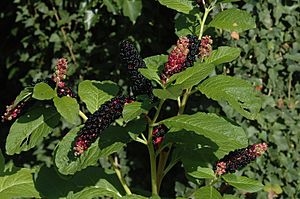Phytolacca facts for kids
Quick facts for kids Phytolacca |
|
|---|---|
 |
|
| Phytolacca acinosa foliage and fruit | |
| Scientific classification |
|
| Kingdom: | Plantae |
| Clade: | Tracheophytes |
| Clade: | Angiosperms |
| Clade: | Eudicots |
| Order: | Caryophyllales |
| Family: | Phytolaccaceae |
| Subfamily: | Phytolaccoideae |
| Genus: | Phytolacca L. |
| Species | |
|
About 25 to 35 species |
|
| Synonyms | |
|
Pircunia Bertero ex Ruschenb. |
|
Phytolacca is a group of plants, also called a genus. These plants are perennials, meaning they live for more than two years. They are found naturally in North America, South America, and East Asia.
Some plants in this group are known by names like pokeweeds, pokebush, pokeberry, pokeroot, or poke sallet. Other names include inkberry and ombú. The name Phytolacca comes from two words. "Phyton" is a Greek word meaning "plant." "Lacca" is a Latin word for a red dye.
Many Phytolacca species have natural chemicals that can be harmful. These chemicals are found in the leaves, stems, roots, flowers, and berries. They can be poisonous to mammals, like humans, if not prepared correctly. However, birds can eat the berries without getting sick. The tiny seeds have very hard shells. They pass through a bird's digestive system without breaking.
Contents
What Phytolacca Plants Look Like
There are about 25 to 35 different kinds of Phytolacca plants. They can be herbs, shrubs, or even trees. They grow from about 1 to 25 meters (3 to 82 feet) tall.
These plants have simple leaves that grow in an alternating pattern along the stem. The leaves are pointed at the end. Their edges can be smooth or crinkled. Some plants lose their leaves in the fall (deciduous), while others keep them all year (evergreen).
The stems of these plants can be green, pink, or red. Their flowers are usually greenish-white to pink. These flowers grow in long clusters called racemes at the end of the stems. After flowering, they turn into round berries. The berries are about 4 to 12 millimeters (0.16 to 0.47 inches) wide. They start green and then ripen to a dark purple or black color.
Types of Phytolacca Species
Here are some of the well-known species in the Phytolacca genus:
- Phytolacca acinosa – This is known as Indian poke. It grows in southern and eastern Asia.
- Phytolacca americana – Called American pokeweed. It is found in North America.
- Phytolacca australis – Grows in western South America.
- Phytolacca dioica – Known as Ombú. This tree grows in subtropical South America.
- Phytolacca dodecandra – Found in Eastern Africa and Madagascar.
- Phytolacca icosandra – Grows in Central and South America.
- Phytolacca japonica – Found in Eastern Asia.
- Phytolacca octandra – Called Red inkplant. It grows in subtropical and tropical areas around the world.
- Phytolacca polyandra – Found in central and southwest China.
- Phytolacca pruinosa – Known as Levantine Pokeweed. It grows in southern Turkey, Cyprus, Lebanon, and Syria.
- Phytolacca sandwicensis – Called Hawaiian Pokeweed. It is native to Hawaii.
Where Phytolacca Plants Live
The ombú tree (Phytolacca dioica) grows on the pampas, which are large grasslands in South America. It is one of the few trees that provide shade in these open areas. Because of this, the ombú is a special symbol of Uruguay, Argentina, and the gaucho culture. Another species, P. weberbaueri from Peru, also grows into a tree.
Both the ombú and P. weberbaueri have very wide bases to their trunks. Their wood is also very soft and can store a lot of water. This helps them survive grass fires and dry periods.
In the Pacific Northwest of North America, pokeweed is considered an invasive species. This means it grows quickly and can take over areas, sometimes harming native plants.
Uses of Phytolacca Plants
Phytolacca americana is sometimes used in traditional medicine and as food. However, it is very important to remember that almost all parts of this plant can be harmful. They must be prepared very carefully to be safe. The root should never be eaten, as it cannot be made safe.
A dish called 'poke salat' is a traditional food in the southern U.S.. To make it safer, the plant is cooked three times. Each time, the water is changed and boiled again. This helps remove some of the harmful parts.
Images for kids
See also
 In Spanish: Phytolacca para niños
In Spanish: Phytolacca para niños



